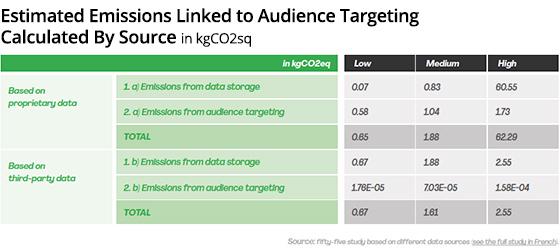
Global warming caused by human activity means that
businesses need to reduce their carbon footprint -- but there are major obstacles in the advertising industry as more consumers shop online.
A recent study from global MarTech consultancy
fifty-five analyzes the “real” carbon cost of goods and services and the impact of digital advertising campaigns.

Based on the agency’s example of a fictitious ad — The Perfume 2022 campaign
— the data-driven estimate of total emissions for a digital advertising campaign is 323 tons of CO2eq. In other words, it is roughly the annual carbon footprint of 16 U.S. citizens. How did
fifty-five land on that number?
Fifty-five released the findings, methodology and best practices for reducing the impact as an open-source tool, allowing anyone to access and leverage it to
drive environmental improvements in digital marketing.
advertisement
advertisement
The study focuses on paid-acquisition channels such as YouTube, Facebook, Instagram, programmatic, and Google Ads.
Future formats
to analyze include TrueView Pre-roll skippable 15 seconds, Bumper Pre-Roll Unskippable 6 seconds, Video Feed, Static Feed, Carousel Feed, Collection Ad, Text Ads, and Shopping Ads.
The goal is
to expand the study’s findings to other types of advertising campaigns, including TV, radio, print, out-of-home, and others.
The study suggests creative production, broadcasting across
advertising channels, and calculation of audience targeting contribute to emissions.
In fact, the data shows that the advertising ecosystem is responsible for more than 3.5% of the world's
greenhouse gas emissions and is growing at a rate of 6% per year, more than commercial airline passenger and cargo flights.
One digital campaign can generate more than 70 tons of mass of
CO2 equivalent (CO2eq), the equivalent of the carbon footprint of about seven people for a year, according to estimates by fifty-five.
To determine this, fifty-five leveraged existing
work and a methodology for calculating greenhouse gas (GHG) emissions, based on mass CO2eq, an indicator common to all sources of emissions, namely.
The study then highlighted approaches a
company could take to reduce emissions by nearly 50%, and in one case, by 70%.
The recommendations include favoring reasoned filming, optimizing video content, and delivering
campaigns via Wi-Fi versus mobile networks, among others.
For Video, Paid Social, and Display channels the study identified four sources of emission.
The agency’s work:
These emissions depend on the total number of days worked to devise the campaign’s media strategy, set it up, monitor it, and produce its final performance reports. One day worked equals
21 kgCO2eq of emissions.
The network used for broadcasting: emissions depend on the network used by the user (WiFi or cellular) and the size of the marketing material. Broadcasting
advertisements via datacenter: emissions depend on the size of the marketing material.
The advertisement’s views: emissions that depend on view time and on the devices used.
Other media, not only programmatic display is a source of emissions. Calculating auctions also create emissions. When a publisher implements an impression on several marketplaces simultaneously,
these marketplaces also use resellers, who can use other resellers to generate extra GHG emissions..
For Display campaigns, the emissions linked to auction calculation is around 50 kgCO2eq,
making up 3% of this channel’s total emissions. The study did not apply the source of emissions to Video and Social channels because, for these channels, advertisers have no control of the
auction system, according to the findings.
For the Sponsored Links channel, the study takes into consideration the emissions linked to the media agency’s work and the emissions linked to
the work of the search engine's algorithm for serving search results.
Emissions linked to an agency’s work depend on the total number of days worked to create the campaign, emissions
linked to the algorithm’s work depend on the volume of query requests by users. This is estimated from the advertiser’s volume of illustration of the calculation of the number of search
requests from the number of impressions for Google search Text ad display.
For an ad--Perfume 2022 - fifty-five. Discover our new perfume with delicate fruity notes. Shipping in under 48h,
free delivery—emissions linked to serving this ad includes:
- Paid Video – 115t
- Paid Social – 115t
- Display – 2t
- Sponsored Links
– 10t
The study also introduced the idea of emissions per impression--CO2e-qPM (CO2eq per 1000 impressions) in reference to the CPM (cost per 1000 impression), which is
frequently used to measure the performance of a campaign.
This KPI serves to demonstrate the differences that exist between channels with an equal volume of impressions, allowing 7 Emissions
for 1000 impressions of the Perfume 2022 campaign in gCO2eqPM to make the right decisions to reduce emissions.
For example, based on the Perfume 2022 campaign, the Video channel returns the
highest CO2eqPM, but it also provides a powerful tool to increase brand awareness.